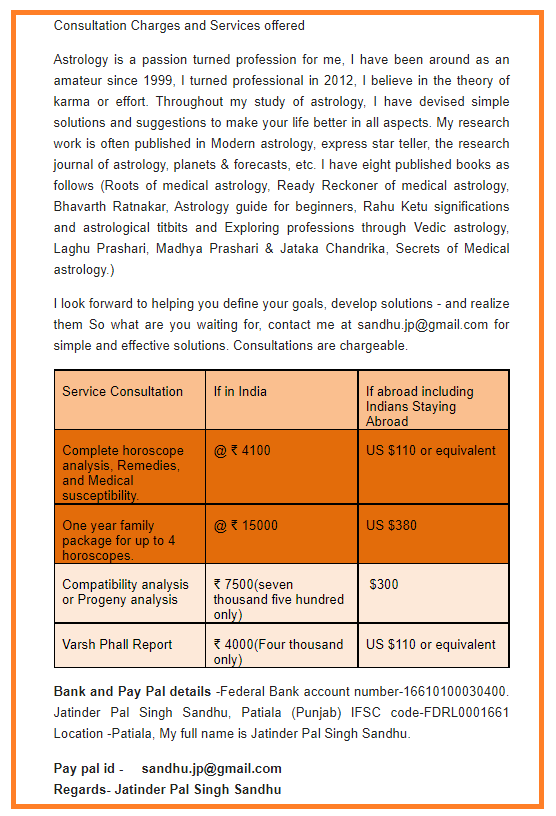It is a universally accepted fact that any faultless astrological technique of exact timing of events either does not exist or lies hidden, although philistine astrologers (nakshatrasoochakas) may declare themselves to be omniscient.
All known methods in Vedic Astrology can be divided into two categories, as far as mathematics is concerned : (1) those dependent upon modern physical astronomy and (2) those relying on traditional methods. Both these categories have numerous variants. Major problem in the first camp is astrologically correct value of ayanāmsha, and main problem in second camp is computational crudities of various types.
We assume that both these camps take for granted that in mathematics sidereal (nirayana) system is correct and in predictive astrology (phalita jyotisha) Brihat-Parāshara-Horā-Shāstra (BPHS) and ancient texts based on or akin to BPHS are to be relied upon, because that is the accepted meaning of Vedic Astrology or Jyotisha.
There cannot be mutually incompatible two correct techniques of timing, either both of them or at least one of them must be incorrect. As far as the first school based on physical astronomy is concerned, all possible values of ayanāmsha have been experimented with during past one hundred years, without any conclusive outcome in the favour of any single value of ayanāmsha. It proves that even after we get some perfect solution to the problem of ayanāmsha, there must be other unrecognized errors which must be removed if we want any exact technique in timing of events. One such source of error is erroneous length of the Vimshottari year. Some software developers, like Sri Jyoti Star in the USA and Kundalee in India, have experimented with various types of Vimshottari years, without any conclusive result, because a third source of error was never noticed by any practitioner of Vedic Astrology among the computer using guys : hidden Saurpakshiya offsets in Drikpakshiya longitudes of planets. Most of the computer using astrologers might not have heard these esoteric terms, whiich are fundamental in the curriculum of Vedic Jyotisha taught in Sanskrit universities of India. These are ancient concepts, and Ketaki system had revived these concepts during 20th century. Kamlakara Bhatta was the most staunch proponent of this Saurpakshiya mathematics during recent centuries, but due to Western hegemony and faith in modern science this ancient system was never tried by any software developer.
Many reputed scholars of Sanskrit universities on India have concluded that unless this beejsamskrita (offset corrected) method of Suryasidhanta is adopted, foolproof timing of events will remain a distant dream. On 18 Oct 2005, after two days of discussions in a conference held at Sampoornanand Sanskrit University in Varanasi, an unanimous decision was taken by academic stalwarts from six states of India that all panchangas of India ought to be made according to Suryasidhanta and a committee headed by me (Vinay Jha) was formed to implement this unanimous decision, whose parties were Dr Nagendra Pandey (currently HOD of Jyotisha at Sampoornanand Sanskrit University in Varanasi), Dr Shukdeva Chaturvedi (former HOD of Lalbahadur Shastri Kendriya Vidyapeetha in Delhi), Dr Ramchandra Pandey (former HOD of Jyotisha of Benaras Hindu University, Varanasi), Dr Radhakanta Mishra (currently HOD of Jyotisha at KSD Sanskrit University in Bihar), etc. This unanimous decision was implemented and eight panchangas were started in many states of India and a horoscope making Kundalee software was also launched, based on the same beejsamskrita Suryasidhantic mathematics.
Mathematical discussion of this tricky affair is not advisable here. My aim here is merely to illustrate, with some examples, this traditional method of Vedic Ganita (mathematics), which was simply known as Siddhanta (theory) by all ancient astrologers of India. Without a sound Siddhānta, a sound predictive astrology is just impossible. There were 18 ancient Siddhāntas, of which Surya Siddhanta was lauded as the best by Varah Mihir. The beauty and greatness of BPHS cannot be properly fathomed unless we use the Ganita (Surya Siddhanta) of those very ancient masters who created Phalita.
Some rules must be observed before we proceed. Rāshi chart should be used only for determining friendships, aspects, strengths, debilities, etc of planets. Predictive work should be entirely based upon the Bhāva-chalita kundali. Many astrologers use Rāshi kundali for predictons because it saves time, and this habit has now become almost a rule ! Ascendant is defined as a point in ecliptic. The latter is elliptical. Hence, ascendant and consequent bhāvas are all parts of this solar ellipse. Rāshi kundali is circular and therefore all 12 parts are equal. But bhāvachalita kundali is elliptical because its 12 bhāvas are unequal.
Now we come to our main theme. Birthtime bhāvachalita (D1) and navamāmsha (D9) kundalis and associated aspect charts are given in following two pictures. Let us explore the timing of marriage of a registered user (cf. ) according to BPHS and Laghuparashari. All the rules and techniques used below are well known to all Vedic astrologers, but these rules work with perfection only if all the three mathematical offsets are taken into account. Following analysis is based on a software (Kundalee) in which all necessary corrections proposed by aforementioned academics have been taken into account.
Birthtime : 17:07:1983 at 19:34, Nellore (14:27 N, 80:02 E)
Marriage time : 10:08:2006 at 11:04, Hyderabad
Saurpakshiya Vimshottari at the time of marriage :
MahaDasha(MD) = Jup, AD = Sat, PD = Rahu,SD = Ven,PrD = Merc
Let us consider birthtime Bhava-chalita (D1) and Navamasha(D9) charts. Following is the aspects (max. 60) on 7th house :
Jup = 51 ; Ketu = 39 ; Sat = 38 ; Moon = 10 ; Rahu = 6 ; others = 0.
Merury resides in 7th house.
Due to more aspect on 7th house than any other planet, marriage took place in Jupiter's MD.
But Ketu and Saturn have nearly equal aspect on 7th. Ketu has Yuti relation with Jupiter, but Saturn has a yuti relation with lord of the 7th house Moon.
Firstly, Jupiter's being lord of 3rd and 12th houses and being merely samagrihi in 11th house is far weaker than exalted Saturn in 9th house with lord of 7th Moon. Hence, yuti relation with Jupiter is not imparting enough weightage to Ketu in its contention with Saturn as a force to reckon with as regards 7th house.
Secondly, Jupiter is friendly to both Ketu and Saturn in bhāvachalita, but in D9 Jupiter is friendly to Saturn but enmical (tātkālika) to Ketu, the latter being further weakened by being placed in 12th house. It forced Ketu out of the race, and made Saturn factor of AD.
Moon in spite of being lord of 7th house had only 10' aspect and in D9 was debilitated in D9, hence it went out of the race. Mercury is combust (asta) with debilitated Sun, hence it was powerless. Jāyākāraka Venus is lord of 8th house, resides in 6th and has no aspect on 7th. Hence it had no effect on marriage. In bhāvachalita, all other planets are totally ineffective in this regard. In D9, exalted Saturn has yuti relation with Mercury and Rahu. Since Mercury is combust in bhāvachalita, Rahu emerges as the most powerful contender for factor behind pratyantara dashā when we consider the combined effect of bhāvachalita and D9.
Among the remaining, we find Jāyākāraka Venus as factor of SD and Mercury sitting in 7th as factor of Prāndashā, in spite of their weaknesses, because all other planets are totally ineffectve. Mercury is 10°:34':35'' degrees away from Sun (after applying Saurpakshiya offset in longitudes according to ancient canons), and is therefore not totally combust. Venus is also not too bad, and therefore its property of Jāyākāraka was not totally destroyed on account of residing in 8th and lacking aspect on 7th.
Careful comparison of all planets in D1and D9 with regard to their influences on 7th house should be made by readers to determine the five planets needed for Vimshottari timing. D1 is bhāvachalita and not Rāshi-chart, because BPHS explicitly uses the word Lagna for D1, and ancient mathematical canon (Suryasiddhānta) defines Lagna as in terms of elliptical ecliptic and not in terms of circular bha-vritta. If such precautions are taken, measure of error in determination of time of events will gradually reduce.
In the chart of husband of this native, two planets are so powerful for the 7th house that they were repeated in Vimshottari sequence Ineffectiveness of other planets also contributed to this.
This topic is growing too big. Such problems should be solved by means of comparison of both types of softwares, popular ones, and Suryasiddhāntic. It is not possible to wipe out Suryasiddhanta in spite of centuries of propaganda against it by Semitic invaders and their intellectual offsprings. Suryasiddhanta is not a text of physical astronomy, its Grahas are incarnations of gods. BPHS also holds same views. Physical planets have no power to control destinies of men and nations, and they cannot be propitiated either. If material planets are accepted to be factors in astrology, their forces must be material forces. But how can we compare the gigantic material forces of Sun and Jupiter with Mercury ? And what is the material force of Rahu or Ketu ? Injecting materialism in astrology is destroying it. Jyotisha, being Vedanga, is a part of Veda, and is a part of religion rather than of material science. Its criterion of truth is not heavenly position of material objects perceived by sense organs, but the reliability of Phalita (predictive branch of astrology). 2000 AD was the year of minimum amount of offset in longitudes between Drikpakshiya (physical) and Saurpakshiya (Suryasiddhāntic) planets. Now, this offset has begun to increase, and will reach the value of 180° in 23000 AD. When this offset was considerable, no one talked of material objects. Observatories are things of Kaliyuga. Astrological Grahas are deities who control lives of creatures.
Reading such arguments, some people start crying wolf about obscurantism. But they forget that all great scientists like Newton, Neils Bohr, Einstein and Schröedinger were believers in God, the last of them being a staunch supporter of Vedanta who got a Nobel Prise by proving through his Wave Mechanics that material things are mere perceptions and nothing exists in the universe excepting Waves (of Consciousness?) : this is what Badarayana and Shankaracharya taught !

